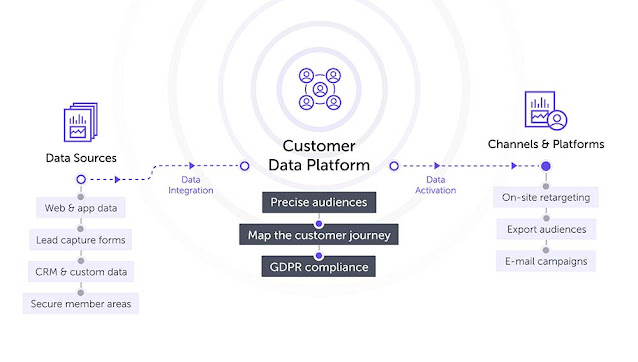 |
| Customer Data Platform |
Customer Data Platforms (CDPs) have emerged as an important player in the
customer data management landscape in recent times. With brands collecting
increasing amounts of data from various customer touchpoints, efficiently
storing, integrating and activating this data for marketing and business
purposes has become critical. Enter CDPs which are specialized platforms
designed to provide a unified, single 360 degree view of customers across
channels and systems.
What is a Customer Data Platform?
A Customer Data Platform or CDP is a packaged software that creates a
persistent, unified customer database that is accessible to other systems. It
centralizes customer profiles collected from various sources like e-commerce
sites, mobile apps, marketing databases, CRM systems, etc. and stitches them
together using unique customer identifiers. This unified customer profile
contains all customer behaviors, transactions, preferences in one place.
Some key characteristics of a CDP include:
- Centralized customer database that acts as a system of record for known
customers
- Ability to ingest large volumes of first-party customer data from various
sources
- Unified customer profiles with a persistent ID that tracks customers across
touchpoints
- Sophisticated data modeling capabilities to segment customers
- Activation capabilities that allow real-time use of profiles for marketing
activities
- APIs that allow easy integration with other systems like data warehouse,
marketing platforms
Benefits of adopting a CDP
There are several strategic and tactical benefits that a CDP provides to
brands:
Single source of truth for customer data
By creating a centralized repository of known customers, Customer
Data Platform provides a single source of truth for all customer
profiles, attributes and behaviors. This eliminates data silos across different
systems.
Better customer insights
By combining data from various touchpoints, CDP enables building a
comprehensive 360 degree view of customer behavior, preferences and attributes.
This improves customer understanding.
Hyper personalized experiences
The unified customer profiles and insights allow creating highly personalized
and contextualized experiences across channels. This strengthens customer
relationships and increases engagement.
Attribution and measurement
Tracking customers via a consistent ID allows attributing customer value and
measuring success of various marketing initiatives. This helps optimize
campaigns for higher returns.
Agility and experimentation
CDPs provide flexibility to iteratively update profiles and model customer segments
in real-time. This enables marketers to test assumptions, launch new
personalized offerings and scale what works quickly.
Future growth opportunities
The 360 degree unified profiles lay the foundation to identify growth
opportunities like cross-sell, up-sell through predictive analytics and
optimize the customer journey.
Key considerations when selecting a CDP
With many CDP vendors in the market, selecting the right platform requires
evaluating certain criteria:
Data integration capabilities
Check what sources the CDP can ingest from and complexity of integration
process. Ease of integration saves time and effort.
First party data focus
Prioritize CDPs optimized for collecting and enhancing first party data over
third party data-led platforms.
Customer matching and profile
unification
Trial the CDP's ID resolution, matching and profiling capabilities to verify
accuracy.
Segmentation & activation tools
Evaluate segmentation models, predictive algorithms and channels supported for
activating insights.
API access and third party integration
Verify ease of integrations with other tools through APIs for a centralized
ecosystem.
Data governance and security controls
Ensure compliance with data regulations and robust access controls and encryption.
Cost and pricing models
Evaluate total cost of ownership including onboarding, storage, usage-based
pricing etc. before signing up.
Vendor stability and product roadmap
Check financial standing and commitment to further innovation and platform enhancements.
Implementing a CDP Project
Getting buy-in and stakeholder alignment
Getting sponsorship from senior leaders is key for a successful CDP
implementation. The business case should highlight potential ROI, competitive
advantage and alignment to strategy. Stakeholders across marketing, product and
IT should be a part of visioning and requirements gathering exercise.
Data audit and analysis
The first step is to audit all existing internal systems and partners
collecting customer touchpoints. Document data dictionaries to understand
available fields, quality, volume and sources. This exercise informs technical
and process requirements for the CDP project.
Platform selection and procurement
Shortlist 2-3 CDP vendors based on needs identified in audit. Request demos
highlighting key criteria. Negotiate commercials and get legal approval before
selecting and procuring best fit platform.
Technical implementation
Focus on API integrations first to ingest historical and streaming data into
the CDP. Simultaneously model customer profiles and segments in staging.
Go-live in phases to test and refine configurations with a smaller dataset
before full production.
Change management and adoption
Educate stakeholders on new capabilities and lexicon. Train teams on profile
views, activation tools and new processes for ongoing governance. Communicate
success milestones to gain organizational buy-in and promote platform usage.
Continuous improvement
Leverage platform enhancements, refine segmentation formulas quarterly based on
new behaviors and constantly measure impact of personalized programs. Look for
opportunities to expand platform scope and consolidate other systems over time.
In today's digital age, superior customer understanding is the key
differentiator for brands. Customer Data Platforms are emerging as the core
infrastructure to drive holistic, long term customer relationships through a
unified profile view. With the right strategic implementation, a CDP can
empower marketers to offer truly personalized experiences attuned to individual
needs and maximize lifetime customer value.
Get More Insights On This Topic: Customer
Data Platform
Explore More Related Topic: India
Ready to Mix Food Market
